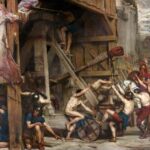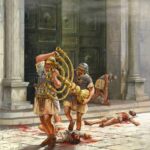The oracles in antiquity were of enormous importance. Starting from the ordinary “gray” people, ending with leaders, rulers and leaders – everyone went there to get the answers to the questions asked. And advice was sought and sought both in private and personal matters.
One of such sanctuaries visited by the Romans was the sanctuary of Jupiter Anxurus in Tarracin. Currently, scientists and researchers assume that the sanctuary was initially dedicated to the ancient Italian goddess Feronia and Venus, with time they were attributed to Jupiter Anxurus the main god of the city of Tarracina (Volsci – the former Italian tribe identified Jupiter with Anxur). After assigning the temple to the goddess Venus, they suggest finds with inscriptions on votive gifts in which we can read that Sulla (Roman politician and dictator) founded a huge temple dedicated to Venus – her goddess guardian.
The temple complex consists of two parts. The first so-called The Small Temple, of which only the ruins of the monumental foundation have survived, consists of a series of rooms in the rock, covered with a brick vault. Above, the rock was leveled to form a terrace. The temple probably stood on it. In the Middle Ages, a monastery was built here, completely destroying the remains of a Roman building, but in some corridors the remains of paintings from the Roman period have been preserved, which researchers included in the first Pompeian style (imitating colored marble cladding).
Based on the preserved frescoes and the technique of building walls, the creation of the sanctuary dates back to the 2nd century BCE.
The Second Temple rises nearby. It was probably created during Sulla’s time. A huge terrace has survived to our times, which was partly hewn in rock. On the south side there are twelve arches through which one entered the rooms that lead through the corridor to the cave. A second cave was also discovered, to which there was no entrance, but only a shaft dug from the terrace. Both caves probably had cult functions.
In the center of the terrace are small remains of the temple. The temple itself was oriented along the north-south axis, which is opposite to the terrace.
Archaeologists speculate that the temple was decorated with Corinthian columns, the remains of which were found during excavations carried out in 1894. It was then that the remains of the cell, the dowry plinth, the remains of a white mosaic framed in black and the decorative roof elements in the shape of lion heads were discovered. Traces of fire were also found.
Behind the temple, remains of a portico were discovered that masked the rock wall and served as a resting place for pilgrims.
Rituals related to the oracle were held in the southeastern part of the sanctuary, where there was a space separated by a wall, in which a rock hewn partially stood. At its top was a chapel with Ionic capitals. A vertical shaft was carved in the rock leading to the cave below. Probably in this place pilgrims received the answer from the oracle. It is also believed that it is also the oldest place of the sanctuary (from the time of the foundation of the Tarracina colony around 329 BCE) older than the architectural assumption created around.
Behind the temple and the portico, the remains of the third terrace were located, which was closed on three sides with porticos and in the center probably also was the temple.








